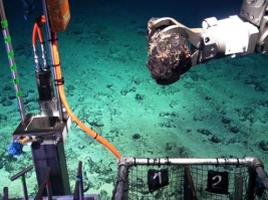 Deep-sea mining has long been a controversial subject. For the last 50 years, proponents have called for the mining of silver, gold, copper, manganese, cobalt, and zinc from the seafloor, while environmentalists have argued that seabed mining should not be permitted because of the potential damage to deep-sea ecosystems. So far, no actual commercial mining has taken place although at least one project is scheduled to start in 2018. Recently a new discovery has, perhaps somewhat paradoxically, renewed interest in undersea mining in order to help produce green energy.
Deep-sea mining has long been a controversial subject. For the last 50 years, proponents have called for the mining of silver, gold, copper, manganese, cobalt, and zinc from the seafloor, while environmentalists have argued that seabed mining should not be permitted because of the potential damage to deep-sea ecosystems. So far, no actual commercial mining has taken place although at least one project is scheduled to start in 2018. Recently a new discovery has, perhaps somewhat paradoxically, renewed interest in undersea mining in order to help produce green energy.
Tellurium is a rare metallic element, number 52 on the Periodic Table, which is a key component used in the fabrication of advanced solar panels. The BBC recently reported that British scientists exploring an underwater mountain in the Atlantic Ocean have discovered a treasure trove of rare minerals, including a particularly rich source of tellurium. The tellurium was reported to be in concentrations 50,000 times higher than in deposits on land. In addition to the tellurium, The rock samples also contained rare earth elements that are used in wind turbines and electronics.
The Tropic Seamount, where the rare mineral have been found, is more than 500 km (300 miles) from the Canary islands. The seamount rises roughly 3,000 meters off the ocean floor and has a flat plateau which is about 1,000 deep.
As reported by the BBC: “Dr Bram Murton, the leader of the expedition, [said] that he had been expecting to find abundant minerals on the seamount but not in such concentrations. “These crusts are astonishingly rich and that’s what makes these rocks so incredibly special and valuable from a resource perspective.”
He has calculated that the 2,670 tonnes of tellurium on this single seamount represents one-twelfth of the world’s total supply. And Dr Murton has come up with a hypothetical estimate that if the entire deposit could be extracted and used to make solar panels, it could meet 65% of the UK’s electricity demand.”
And here lies the paradox. Tellurium could play a significant part in generating green, non-polluting energy. On the other hand hand, is it worthwhile to risk significant environment damage and pollution under the sea in order to mine it?
Dr. Murton commented to the BBC: “If we need green energy supplies, then we need the raw materials to make the devices that produce the energy so, yes, the raw materials have to come from somewhere. We either dig them up from the ground and make a very large hole or dig them from the seabed and make a comparatively smaller hole. It’s a dilemma for society – nothing we do comes without a cost.”
Research is now underway to better understand the impact of undersea mining on the ocean environment.
Thanks to David Rye for contributing to this post.

This is fascinating. Hopefully this isnt the last we hear of this article.